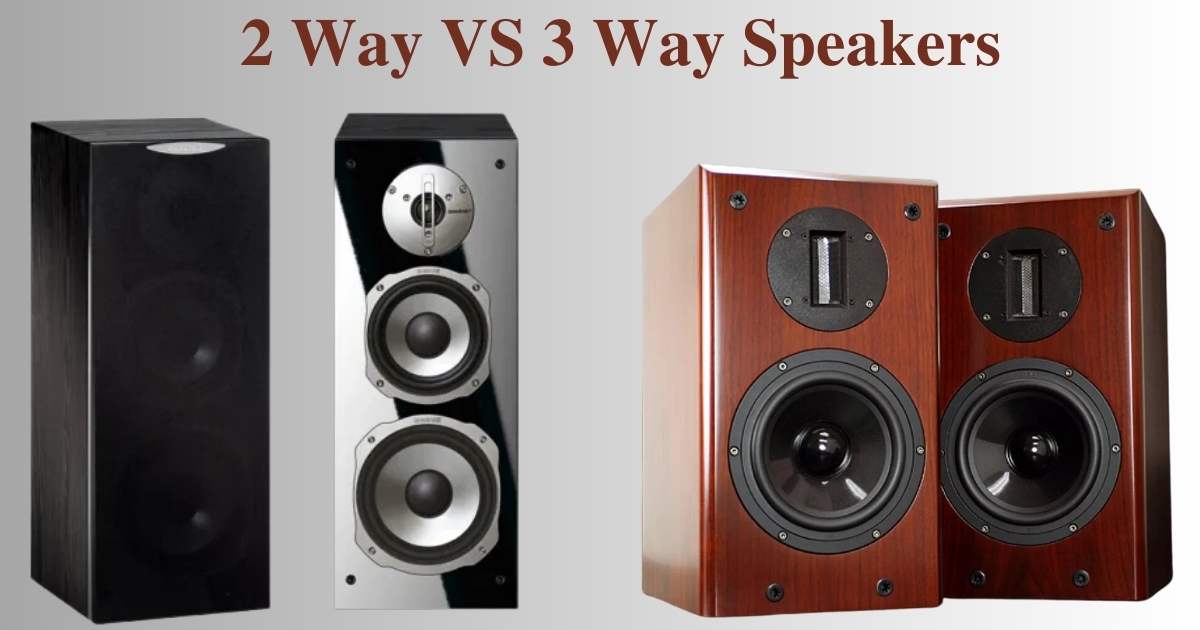The quality of your speakers plays a major role in your audio listening experience.
From accurate music reproduction to clear dialogue in movies, the right speaker system can take your entertainment to the next level.
When it comes to speakers, two main configurations exist – 2-way and 3-way speaker systems. But which type gives you better sound?
What are 2-Way and 3-Way Speakers?
2-way speakers contain two driver components – a woofer and a tweeter:
- Woofers handle low-frequency sounds like bass and lower midrange. They reproduce the thump and rumble.
- Tweeters produce high-frequency sounds like cymbals and vocals. They provide the crispness and detail.
In a 2-way speaker, the woofer and tweeter each cover a portion of the audible frequency range, separated by a frequency filter called a crossover.
3-way speakers add a midrange driver:
- The midrange handles the middle frequencies that fall between the woofer’s and tweeter’s ranges.
Adding the midrange driver allows each component to focus on a smaller specific frequency band. This leads to improved sound dispersion and accuracy.
Which Way to Go? 2-Way or 3-Way?
When choosing between 2-way and 3-way speaker systems, consider factors like:
- Size – 3-way speakers are larger to house the extra midrange driver.
- Application – 3-ways excel for critical listening like studios. 2-ways work for casual listening.
- Audio quality – 3-way speakers reproduce the full frequency spectrum better.
Benefits of 2-way speakers:
- More compact and smaller size
- Lightweight and easier to mount
- Affordable price point
Downsides of 2-way speakers:
- Can’t handle the full frequency range as accurately
- More limited sound dispersion
Benefits of 3-way speakers:
- Reproduce full spectrum with precision
- Better sound imaging and separation
- Ideal for critical listening
Downsides of 3-way speakers:
- Larger size and footprint
- Higher costs than 2-way
Major Differences Between 2-Way and 3-Way Speakers
Frequency Range Handling
- 2-way speakers can’t reproduce midrange as accurately due to gaps between woofer and tweeter ranges.
- 3-way speakers deliver the midrange evenly for balanced sound across the spectrum.
Sound Dispersion and Imaging
- 2-way speakers can suffer from uneven sound dispersion in the crossover zone.
- 3-way speakers with dedicated midrange have superior stereo imaging and channel separation.
Crossover Network Requirements
- 2-way crossovers are simpler with a single crossover point.
- 3-way crossovers are more complex to integrate 3 drivers and need high-end design.
Size and Placement
- 2-way speakers take up less space and can fit into smaller rooms.
- 3-way speakers have a larger footprint and need adequate clearance for the midrange.
Cost Differences
- 2-way speakers range from affordable to high-end options.
- 3-way speakers come at a premium price point.
FAQ’s About 2-Way and 3-Way Speakers
What is better 2 way or 3 way speakers?
It depends on your needs and application. 3-way speakers objectively reproduce the full audio spectrum better and are ideal for critical listening.
But 2-way speakers provide a more compact and affordable option for casual listening and smaller spaces.
What are the benefits of 3 way speakers?
The main benefits of 3-way speakers are wider frequency response for balanced sound, precise stereo imaging, and smooth dispersion with dedicated midrange drivers.
This makes them well-suited for studio monitoring and high-end audiophile listening.
What are the benefits of a 2 way speaker?
The benefits of 2-way speakers include smaller size, lighter weight, easier placement, and lower cost.
They work well for home theater, background music, and entry-level hifi applications where compact footprint and budget are priorities.
What is the difference between 2 way and 3 way monitors?
Studio monitors aim for the most accurate, neutral sound reproduction possible. 3-way monitors deliver flatter response across the full frequency range with better soundstage imaging compared to 2-way monitors. The midrange clarity of 3-ways provides more precise mixing capability.
What does 2 way monitor mean?
A 2-way monitor uses a woofer and tweeter speaker configuration without a dedicated midrange driver.
It can still provide decent frequency response for casual listening but lacks the midrange accuracy of a 3-way monitor design best suited for audio engineering and mixing work.
Also Read This:
Final Thoughts
When choosing between 2-way vs 3-way loudspeakers, consider your needs. 3-way speakers objectively perform better across the whole audible range and are ideal for critical listening and sound engineering.
But 2-way speakers provide a smaller, more budget-friendly option for music and home theater in a compact space.
Determine how you will use the speakers and your available room size and budget to select the right system for your audio needs. With the right setup, you can enjoy crisp, balanced sound.



![Beacons.ai A Complete Guide to the AI-Powered Link in Bio Platform [2024 Review]](https://techplces.com/wp-content/uploads/2024/10/Beacons.ai-A-Complete-Guide-to-the-AI-Powered-Link-in-Bio-Platform-2024-Review-300x157.jpg)







![Beacons.ai A Complete Guide to the AI-Powered Link in Bio Platform [2024 Review]](https://techplces.com/wp-content/uploads/2024/10/Beacons.ai-A-Complete-Guide-to-the-AI-Powered-Link-in-Bio-Platform-2024-Review-150x150.jpg)